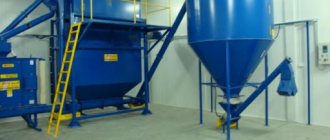Business relevance
Wheat is a crop whose demand always remains consistently high. But many farmers refuse to cultivate it due to difficulties in cultivation and low price for wholesale sales - a ton of quality grain costs 50,000 tenge, which is 5 times lower than the cost of the same volume of lentils.
The same field cannot be used for growing cereals for several years in a row, since the land is depleted and the yield falls. Accordingly, it is necessary to sow fields with other crops, and sow wheat in new areas. But, despite all the difficulties, the business of growing wheat remains relevant - there is low competition in this segment, conditions for the growth of cereals in Kazakhstan are suitable, and the sales market is not oversaturated.
Wheat production in China
China is the world's main wheat producer. In 2014, China's share in world production of this grain crop was 17.3%, production volume was 126.2 million tons. Over 10 years, compared to 2004, wheat production in China increased by 37.3% or 34.3 million tons. Due to limited available land, China's wheat production growth is expected to slow significantly over the next 10 years. By 2024, according to the OECD forecast, it will reach 130.9 million tons, which is almost at the level of modern levels. According to the USDA, China's wheat harvest will reach 133.1 million tons by the 2024/2025 agricultural year.
Land for sowing
For a wheat growing business to be profitable, sow large areas of at least 100 hectares in size. It is not uncommon to rent plots of 1,000 hectares or more in order to get more crops and, accordingly, increase profitability and profits. When drawing up a business plan, keep in mind that large flour mills prefer to work with wholesale suppliers; they are not interested in purchasing small quantities of grain.
If the land for crops is not owned, then renting is the best option. Sign the contract for a year, and if necessary, you can extend it for the required period. The cost of a hectare of field suitable for sowing wheat varies from 14 to 17 thousand tenge; when signing a lease agreement for a large area, the price per hectare will be lower. Typically, landlords charge for the entire year at once, which is expensive for businesses, so try to negotiate a monthly payment.
There are special requirements for soil quality. Suitable for wheat:
- chernozem and chestnut soil - when growing crops on fertile lands, significant savings are obtained on fertilizers, since they are needed in minimal quantities;
- soddy-podzolic and forest gray soil - when a certain amount of fertilizing and fertilizer is applied, wheat will give a good harvest.
To obtain a bountiful harvest, you need slightly acidic or neutral soil, the pH of which is in the range of 7.5-7.7. Alkaline soil is not suitable for this crop.
Wheat production in India
Among wheat producing countries in 2014, India is in 2nd place with a volume of 94.5 million tons. Over 10 years, the figures increased by 30.9% or 22.3 million tons. In India, the reserves of areas suitable for expansion are also limited, however, due to some technological backwardness in the field of growing crops, there is the possibility of a sustainable intensive increase in production volumes. With the introduction of advanced technologies into the production process, the yield can increase significantly. According to OECD forecasts, by 2024 wheat harvest in India will reach 110.2 million tons - an increase of 16.6% or 15.7 million tons. The USDA's forecast for wheat production in India is more moderate. By the 2024/2025 agricultural year, production will increase by 7.5% compared to 2014/2015.
Selecting a wheat variety
Among all cultivated crops, wheat holds the record for the number of varieties grown - there are more than 30 of them. The following types of wheat are most often cultivated:
- hard;
- einkorn;
- Boeotian;
- soft;
- Einkorn.
When choosing a variety, you should focus on yield, consumption volumes (to do this, study the demand), and the characteristics of the available soil. Also decide what type of cereal you will grow - feed (feed) or food wheat. According to statistics, the consumption volumes of forage species are more in demand, the demand for these products is higher. If space allows, sow both types of grain crops - this will allow you to reach a larger volume of consumers.
Sowing technology is divided into two types - it can be winter or spring. Winter varieties are sown in late summer or autumn, and spring varieties in spring. There is a practice of sowing winter wheat, and after harvesting it, sowing the field with a spring crop. This allows you to harvest two crops in a year, but increases the risks of soil depletion and the inability to carry out harvesting and planting work on time due to the unripening of cereals due to bad weather conditions.
Wheat production in the world
World wheat production in 2014, according to FAO, amounted to 729.0 million tons. This is 2.5% more than in 2013. Compared to the indicators of ten years ago (by 2004), production volume increased by 15.3% or 96.8 thousand tons.
World wheat production in 2020, according to OECD estimates, is at 723.8 thousand tons. According to the forecasts of this organization, no significant changes in global wheat production are expected in 2020.
Over the next 10 years, the growth in global wheat production will slow down. By 2024, the figures will increase by 7.9% or 59.7 million tons compared to 2014.
The USDA also predicts a slowdown in the growth of wheat production in the world over the next 10 years. In the 2024/2025 agricultural year, the global wheat harvest, according to forecasts of this organization, will amount to 776.2 million tons, which is 6.6% more than in 2014/2015.
Features of sowing
Think about what crop will replace wheat, since proper farming does not involve sowing fields with the same crops year after year. Correctly selected precursors help increase yield and improve grain quality. Best predecessors:
- oats grown for green fodder or hay;
- grain legumes;
- barley for monofeed;
- corn for silage;
- leguminous herbs.
Proper organization of crop rotation involves the organization of free fallow - a year when from spring to autumn the field is not sown, but preventive work is carried out on it to fertilize the soil and care for it. Accordingly, to obtain a stable annual profit, it is worth dividing the land into 3 sections:
- first - do not sow;
- second, grow a suitable predecessor crop on it;
- third - sow wheat.
The next year the plots are alternated. This approach will allow you to avoid a number of diseases to which plants are susceptible, not to deteriorate the quality of the crop, and to obtain a consistently high yield.
Wheat production in Russia
Among wheat producing countries, Russia ranks 3rd in the world. In 2014, wheat production in Russia amounted to 59.7 million tons (8.2% of world production).
Over 10 years, the figures increased by 31.4% or 16.6 million tons. According to AB-Center estimates, in 2020 the volume of wheat production in the Russian Federation exceeded 62 million tons ; according to the Ministry of Agriculture of the Russian Federation, it amounted to 63.8 million tons.
It is worth noting that the wheat harvest in the Russian Federation of over 60 million tons was predicted by the OECD only by 2021.
USDA forecasts for wheat production in the Russian Federation are at similar levels - up to 62.1 million tons in the 2024/2025 agricultural year. At the same time, this organization’s forecast for wheat exports from the Russian Federation is more positive - growth over the next 10 years by 22.0%.
The steady growth of wheat production in Russia, according to AB-Center, is due to a number of factors, such as:
- growth in consumption in the domestic market (including an increase in the livestock industry’s need for feed);
- development of logistics infrastructure, which made it possible to significantly increase export volumes;
- increasing wheat yield. Analysis of average annual indicators over a long period allows us to largely eliminate the influence of natural and climatic factors and determine the contribution of the use of advanced technologies to changes in wheat yield in Russia. The average annual yield of this main type of grain in Russia, according to calculations based on Rosstat data, in 1991-2000. was 16.4 c/ha, in 2001-2010. – increased to 20.5 c/ha, in 2011-2015. – reached 22.5 c/ha.
How much planting material is needed?
To uniformly sow fields with wheat, it is necessary to calculate the amount of planting material. Depending on the variety of cereals, soil fertility and soil fatigue, climatic conditions and other factors, 100 to 150 kg of seed material is needed per 1 hectare. And to sow 200 hectares at a rate of 150 kg per 1 hectare, 30 tons will be required. The average cost of 1 ton of seed is 35,000 tenge, the purchase will cost 1,050,000 tenge. This amount is approximate, it may be higher if an expensive variety is chosen.
Buy seeds from specialized companies or farms that have proven themselves in the market to get high-quality seeds that are not infected with any disease and give a high yield. You only need to purchase seeds in the first year; in the future, you can use self-grown seed.
Wheat in Rus'
The Slavs, who from time immemorial inhabited the territory of modern Russia, were mainly engaged in agriculture. The main cereals cultivated were:
- wheat - mostly in the south;
- rye - in the north;
- barley - in the very north of the agricultural zone, in harsh climatic conditions.
When did they start growing
Wheat appeared in Rus' in the 5th century BC. e. This is one of the very first cereals grown by the Indo-Europeans, including the Slavs. Our ancestors borrowed it from the Goths who lived in the south of Eastern Europe. The word "bread" comes from the Gothic Hlaifs.
Wheat became one of the first crops grown by the Slavs. It is mentioned in the earliest written records. But rye appeared on our lands only in the 11th-12th centuries. This is evidenced by the records of Nestor the chronicler and materials from archaeological excavations in Novgorod. However, thanks to its resistance to the unfavorable northern climate, rye very quickly spread throughout the territory of what is now Russia. However, in the southern regions wheat invariably dominated.
What species were grown?
The Slavs grew a completely different type of wheat than we are used to today. They sown one of its ancient species - spelt. This is a semi-wild cereal crop, a relative of durum wheat. It is called "einkorn". Spelled grain is covered with several layers of film.
Whole spelled grains, crushed and ground, were often cooked. This is where the Russian name “wheat” comes from – from the Old Church Slavonic root *рьšенъ – “to push”, “toloch”, “to rub”. In ancient Russian written monuments of the 11th century, this word appears frequently.
Today, interest in this ancient culture is being revived all over the world. The high fiber content along with a small amount of gluten makes prehistoric wheat an ideal product for a healthy and hypoallergenic diet.
Equipment and premises
From the premises you need:
- barn for storing wheat - build it from high-quality materials so that the products do not become damp;
- garage for equipment and tool storage.
The equipment is divided into 2 types - it is intended for caring for crops and for harvesting. The most expensive is a wheat harvester, so it is advisable to rent it for a certain period rather than purchase it at the initial stage.
For personal use, purchase:
- Seeder.
- Tractor.
- Mower.
- Cultivator.
- Freight transport.
- Plow and harrow.
- Peeler.
To reduce costs, purchase equipment on credit or purchase used units. You can also rent the cars listed above, this is convenient if you have a small starting capital. If you have a decent amount of money, purchase new equipment - this is beneficial in terms of reducing repair costs.
The amount of equipment needed depends on the area being sown; if necessary, purchase several units of units to speed up sowing and harvesting. The required number of machines minimizes the need for manual labor, which allows saving on wages.
Wheat care
Growing wheat is considered one of the simplest, but to obtain a large harvest, the crop requires some care.
Key activities include (Figure 6):
- Rolling is carried out immediately after sowing. This helps the grains have better contact with the soil and germinate more evenly.
- Harrowing is necessary because after rains a crust forms on the surface of the earth, which is removed by light harrowing.
- Snow delay. Preserving snow cover helps grains better withstand the winter and maintain germination. To do this, it is better to sow the crop in fields protected on the sides from the winds by forest belts or other plantings.
- Removing weeds. The development of cereals at the seedling emergence stage can be slowed down by weeds. At the stage of germination of unwanted plants, special horicides are used.
- Fighting diseases. In order to prevent diseases, crops are treated with special chemicals, dividing the application of such products according to growth phases.
Figure 6. Crop care: rolling, harrowing and fertilizing
Staff
Do not hire employees for permanent work; it is enough to conclude a temporary contract with them for a certain period. You can find personnel to service equipment and work in the field in the nearest locality; as a rule, people there are happy even with seasonal income due to the lack of other work options.
Take on leadership positions - deal with planning, calculations, accounting, searching for sales channels and other issues. Hire:
- an agronomist - his practical advice will allow you to avoid a number of mistakes that, if not approached correctly, can become fatal for a business;
- combine operator;
- combine-tractor driver;
- general workers.
The number of employees depends on the scale of the business project.
Risks and benefits of business
When developing a business plan for growing wheat, take into account possible risks and ways to minimize them. These include:
- Reduced cost with high yield. To avoid financial losses, enter into futures contracts.
- Low yield. Insure the crop in this case to receive compensation.
- Delays in delivery due to equipment failure. Find several options for renting equipment.
Business benefits include:
- High demand for products.
- Low level of competition.
- There is a small financial barrier to entry into this segment of entrepreneurship.
Equipment for growing wheat
Caring for wheat is not like growing garlic in open ground: it is almost impossible to cultivate a huge field by hand. But the cost of the equipment can hardly be called adequate: for example, even a used disc cultivator will not be sold to a farmer for less than two hundred thousand rubles. To save money at the start, it is advisable to purchase a basic set of agricultural implements, and rent a grain harvester, which costs at least three million rubles, for the duration of the harvest. With this organization of work, to service a site of one hundred hectares you will need:
Equipment for growing wheat
| Name | price, rub. | Quantity, pcs. | Amount, rub. |
| Technique | |||
| Tractor MTZ-82 | 850000 | 1 | 850000 |
| High side trailer | 285000 | 1 | 285000 |
| Grain seeder | 225000 | 1 | 225000 |
| Multi-body plow | 30000 | 1 | 30000 |
| Disc harrow | 175000 | 1 | 175000 |
| Peeler | 370000 | 1 | 370000 |
| Universal cultivator | 120000 | 1 | 120000 |
| Fertilizer spreader | 69200 | 1 | 69200 |
| Spring harrow | 260000 | 1 | 260000 |
| Boom sprayer | 115000 | 1 | 115000 |
| Grain storage hopper | 350000 | 1 | 350000 |
| Press roller | 165000 | 1 | 165000 |
| Freight car | 499000 | 1 | 499000 |
| Other equipment | |||
| Seed treater | 211000 | 1 | 211000 |
| Soil Parameter Analyzer | 13800 | 1 | 13800 |
| Total: | 3738000 | ||
Calculation of costs and profits
On average, you will have to spend 4,000,00 tenge to start a business, excluding the purchase of equipment. Include in your initial expenses:
- rent for fields (200 hectares) - 1,200,000 tenge per year;
- purchase of seed - 1,050,000 tenge;
- purchase of fertilizers and processing agents - 580,000 tenge;
- employee salaries;
- unexpected expenses.
The approximate profit level depends on the size of the fields sown and the yield. From 1 hectare you can collect 2.5 tons of grain, respectively, from 200 hectares - 500 tons. The cost of a ton of products for wholesale sales is 50,000 tenge; when selling the entire volume of the crop, the profit will be 25,000,000 tenge.
The funds received in the first year will allow you to recoup the costs of purchasing equipment (if it was not rented) and compensate for other expenses. In subsequent years there will be no large expenses for the purchase of equipment, so the profit will be higher.
The profitability of the business varies between 28-35%, and the payback period is no more than 14 months. The profitability of the project can be increased by renting larger areas, but this increases the initial costs. The exact profit can only be calculated in a specific case, since it is necessary to calculate how much the positive dynamics of grain growth coincides with the sown areas. To get higher profits, sell your crops in winter, when grain prices rise.
Growing wheat is a business characterized by a low level of competition, associated with a number of risks, requiring considerable investments, but at the same time quite profitable, allowing entrepreneurs to return their investments in just one season. To successfully grow cereals, you need to draw up a detailed business plan, enter into agreements with land and equipment lessors, seed suppliers and wholesale buyers.
Wheat producing countries
Wheat is produced in more than 100 countries around the world. At the same time, in 53 countries of the world in 2014, the volume of wheat production was over 1 million tons.
The largest 10 wheat-producing countries accounted for 69.6% of the global wheat harvest in 2014. These countries are China, India, Russia, USA, France, Canada, Germany, Pakistan, Australia and Ukraine.
The TOP 30 wheat producing countries in the world account for 92.4% of the total harvest. In addition to the above countries, the TOP 30 in 2014 included Turkey, Great Britain, Argentina, Kazakhstan, Poland, Egypt, Iran, Romania, Italy, Uzbekistan, Spain, Brazil, Czech Republic, Afghanistan, Bulgaria, Hungary, Morocco, Denmark, Ethiopia and Iraq.
Below are current and projected wheat production trends in the three largest producing countries.











